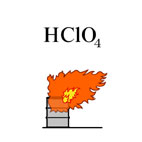| Case Name |
Explosion due to deviation of experimental conditions during preparation experiment of phenylene sulfide |
| Pictograph |

|
| Date |
October 1992 |
| Place |
Tokyo, Japan |
| Location |
Laboratory in a university |
| Overview |
In a university laboratory, an explosion occurred and a fire broke out while phenylene sulfide was being synthesized because the drip rate of the solution was too high. The person in charge had left the site, and then the reaction went out of control. Thorough hazard assessment and education on the reaction were possibly not carried out. |
| Incident |
In the university laboratory, an experiment was conducted by dripping perchloric acid (catalyst) into a diphenylene disulfide and thioanisole sulfoxide solution to synthesize phenylene sulfide. An explosion occurred 10 minutes after the dripping was completed. Another experiment to keep the temperature at 250 °C was being conducted in the same draft chamber.
Phenylene sulfide is a monomer of a kind of the engineering plastic, PPS (polyphenylene sulfide). |
| Processing |
Research and Development |
| Process Flow |
Fig2.Unit process flow chart
|
| Chemical Reaction |
Other |
| Chemical Equation |
Fig3.Chemical reaction formula
|
| Substance |
Diphenylene disulfide, Fig4 |
| Thioanisole sulfoxide. Fig5 |
| Perchloric acid, Fig6 |
| Type of Accident |
Explosion, fire |
| Sequence |
A diphenylene disulfide and thioanisole sulfoxide solution was charged into a flask.
The solution in the flask was stirred and cooled in an ice bath with water, ice, and salt.
70% perchloric acid was added for 10 minutes while the dripping rate was controlled so that the temperature of the solution should not exceed 40 °C.
After the dripping was completed, the person in charge left the site.
The temperature became uncontrollable and there was a runaway reaction.
An explosion occurred and fire broke out. |
| Cause |
The dripping rate of perchloric acid was too high. As the person in charge had left the site before the reaction finished, it went out of control. Furthermore, the temperature could not be maintained because there was another experiment to maintain the temperature at 250 °C using the same draft and ice used for cooling melted. |
| Countermeasures |
Basic education should be provided to students (including graduate students), e.g.
1. Reconfirmation of discipline when doing experiments.
2. Explanation of skills required when doing experiments and the reasons why the drip rate is regulated. |
| Knowledge Comment |
Thorough assessment of reaction hazards needs to be carried out.
Do not leave the workbench during an experiment. |
| Background |
The main cause was that the experiment was conducted at the same time with another one, and monitoring and checks on each experiment were neglected. For instance, operation of heating to 250 °C was conducted next to where an attempt to maintain a temperature of 40 °C with ice was made. Furthermore, the person in charge left the experiment site before the reaction finishes although the dripping continued. The above showed a lack of safety awareness, and there was also a problem in education. |
| Incidental Discussion |
In the small size experiment, the reaction temperature was regulated only by the temperature of the bath. Therefore, there was a possibility that the person might have performed the experiment without understanding about the accumulation and transfer of heat of reaction. |
| Reason for Adding to DB |
Example of accident occurred at university |
| Scenario |
| Primary Scenario
|
Organizational Problems, Inflexible Management Structure, Insufficient Education/Training, Insufficient Analysis or Research, Insufficient Prior Research, Inadequate Evaluation of Reaction Danger, Carelessness, Insufficient Understanding, Insufficient Recognition of Risk, Other Reaction, Malicious Act, Rule Violation, Safety Rule Violation, Regular Operation, Erroneous Operation, Over Supply Rate, Secondary Damage, External Damage, Explosion/Fire
|
|
| Sources |
M. Tamura, M. Wakakura, Fire during experiment to synthesize phenylene sulfide, Reaction danger. -Accident case and analysis- p.128 (1995)
|
| Physical Damage |
Damage to a laboratory table. |
| Multimedia Files |
Fig4.Chemical formula
|
|
Fig5.Chemical formula
|
|
Fig6.Chemical formula
|
| Notes |
Runaway reaction |
| Field |
Chemicals and Plants
|
| Author |
WADA, Yuji (National Institute of Advanced Industrial Science and Technology)
TAMURA, Masamitsu (Center for Risk Management and Safety Sciences, Yokohama National University)
|